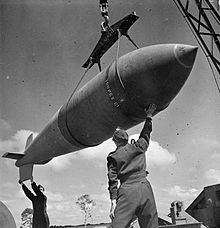Tallboy
Jump to navigation
Jump to search
See also: tallboy
English[edit]

Noun[edit]
Tallboy (countable and uncountable, plural Tallboys)
- (military, historical) An earthquake bomb developed for the British Armed Forces and deployed by the RAF during World War II.
- 2002, Jak P. Mallmann Showell, Hitler's U-boat Bases[1], page 140:
- This is understandable inasmuch that the majority of observers were inside the air raid shelters by the time Tallboys started exploding and time delay fuses added even more to the confusion.
- 2009, Leo McKinstry, Lancaster: The Second World War's Greatest Bomber[2]:
- The 12,000-pound ‘Tallboy’ was another creation from Barnes Wallis, who had long been privately working on the new generation of heavyweight, aerodynamic bombs. […] Reaching a terminal velocity or 3,700 feet per second, the Tallboy was capable of making a crater that would have taken 5,000 tons of earth to fill.
- 2014, Ben Kite, Stout Hearts: The British and Canadians in Normandy 1944[3], page 226:
- The first occasion that the Tallboy was used in support of the Normandy campaign was on the night 8-9 June against the Saumur railway tunnel. […] Twenty three Tallboys were dropped, most falling near the markers at the mouth of the tunnel causing great damage.
- 2014, George 'Johnny' Johnson, The Last British Dambuster: One man's extraordinary life and the raid that changed history[4], page 5:
- Joe's nose art was Chuck-Chuck, a panda that was variously depicted driving a Jeep, carrying a Tallboy bomb or, to symbolise the British/American connection, wearing a top hat decorated with the American flag and a vest bearing the Union Jack and carrying a cigarette in a holder to represent President Roosevelt while smoking a cigar to represent Winston Churchill.
- 2015, Sam Gooch, Group Captain John 'Joe' Collier DSO, DFC and Bar[5]:
- Production of Tallboys was limited to one a day in Britain, and although thirty per week were being made in America, the convoys bringing them over could be held up by bad weather and the continuing (if decreasing) threat from U-boats.
